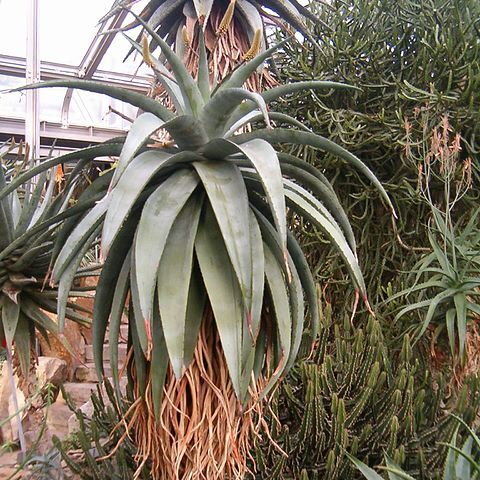Plants solitary, with stem simple, 2-4 met. high, densely bearded with the remains of old dried leaves. Leaves densely rosulate, dull green to glaucous, spreading to slightly recurved, about 1 met. long, 15 cm broad near base, gradually tapering to the apex; upper surface usually rather deeply channelled and without scattered spines; lower surface convex, without spines except for a few in median line near apex, but sometimes with several irregularly scattered spines throughout; margins with a reddish cartilaginous edge, armed with small reddish to reddish-brown pungent deltoid teeth, about 3 mm long, 15-20 mm distant. Inflorescence a divaricately branched panicle, usually 1 only, about 1 met, high, branched low down and producing 6-12 racemes, the terminal raceme usually longer and standing out higher than the others. Peduncle stout, somewhat sulcate, laterally compressed low down, the branches below racemes with several sterile bracts. Racemes densely multiflowered, cylindric, slightly acuminate, 50-80 cm long, 10 cm diam., the terminal frequently the longest, the buds and flowers horizontally disposed, or spreading slightly downwards. Bracts ovate-deltoid, thin, scarious, white, 10 mm long, 5 mm broad at base, about 5-7-nerved, Pedicels 6 mm long. Perianth cylindric-clavate, roundly trigonous, sometimes slightly ventricose, averaging 32 mm long, narrower at base, enlarging towards the throat and with the mouth slightly upturned, usually scarlet, sometimes rose-pink or orange; outer segments free for half to two-thirds their length (tube about 15-I8 mm), with 3 greenish to orange nerves confluent at apex, the 2 upper segment apices falcately connivent; inner segments free, but dorsally adnate to the outer for one-third their length, broader than the outer (10 mm broad at middle), with thin white marginal border and 3 congested nerves, the central nerve raised and forming an orange to brownish keel, the lateral nerves not raised, green, the apices clear white, and more obtuse and more spreading to revolute than the outer. Filaments filiform-flattened, the 3 inner narrower and lengthening in advance of the 3 outer, the included part lemon, the exserted portion deep orange. Anthers the 3 inner and 3 outer in turn exserted 20 mm Style lemon within the perianth, the exserted part yellow. Stigma at length exserted 20 mm. Ovary 6 mm long, 3 mm diam., finely 6-grooved, green.
More
Solitary, arborescent plant up to 2-4 m high. Stem simple, erect, 2-4(-8)m high, densely covered with persistent, down-curved, dried leaves. Leaves densely rosulate, spreading to recurved, dull green to glaucous, without spots, surfaces smooth, lanceolate-ensiform, ± 100 cm long, 15 cm wide at base, lower surface with few spines in median line near apex, occasionally with few scattered spines; margin reddish, cartilaginous, with pungent, reddish to brownish red, deltoid teeth, ± 3 mm long, 15-20 mm apart; exudate honey coloured. Inflorescence usually single, ± 1 m high, erect, 5-to 12-branched from below middle, branches erect. Peduncle stout, somewhat sulcate, compressed low down; with several sterile bracts below racemes. Racemes cylindric, slightly acuminate, 50-80 cm long, ± 10 cm wide, terminal raceme often the longest, presenting higher than lateral racemes, very dense; buds horizontal, flowers horizontal or nodding when open. Floral bracts ovate-deltoid, ± 10 mm long, ± 5 mm wide, white, thin, scarious, 5-to 7-nerved. Pedicels 6 mm long. Flowers: perianth scarlet, sometimes rose-pink or orange, with white or pale segment tips, ± 32 mm long, ± 5 mm across ovary, widening above ovary to ± 8 mm towards slightly upturned mouth, clavate-cylindric, slightly ventricose; outer segments free for 16-22 mm, tips spreading to slightly flared; stamens with filiform-flattened filaments, included part lemon, exserted part deep orange to purplish, exserted 20 mm; ovary 6 mm long, 3 mm diameter, green; style with included portion lemon, exserted portion yellow, exserted 20 mm.

